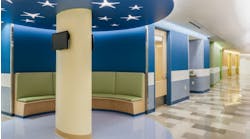A key step in providing good acoustics in a classroom is minimizing background noise. That can be a challenge when a facility's heating and ventilation systems, electrical equipment and plumbing generate noise that penetrates instructional areas.
In Philadelphia, for instance, the criteria for acoustics “is in conflict with the (district's) preferred HVAC delivery system of unit ventilators,” according to the district's Building Design Criteria and Technical Standards. “This will require close coordination between the designers of the acoustics and HVAC systems.”
The district's design criteria set out guidelines for HVAC, plumbing and electrical systems. In general, the criteria state that designers should situate equipment as far away from student locations as possible; where several pieces of equipment together create excessive noise in a learning space, the design should include additional sound-attenuation features.
Here are some of the guidelines related to specific systems:
-
HVAC: Put all rotating equipment with static pressure control dampers at least 10 feet from classrooms. Put HVAC fan equipment serving more than one classroom farther from the classrooms than equipment serving only one classroom. Specify airfoil-shaped blades for centrifugal fans. Do not specify fans with forward curved blades. Do not place variable-air-volume boxes over a learning space unless measures are taken to meet required acoustic standards for the spaces.
-
Plumbing: Run piping above corridor ceilings, not habitable spaces. Specify cast iron for waste-line piping whenever possible. Specify that all piping be isolated from building walls and structures by using compressible wrapping or resilient clamps and hangers. Where a plumbing wall must be situated next to a learning space, design the wall with a 1-inch gap between double rows of studs and two layers of gypsum board on the classroom side, plus sound-absorbing insulation batts in both stud cavities; or use solid masonry construction.
-
Electrical: Specify low-noise light fixture ballasts. Put outlet and junction boxes on opposite sides of a stud wall so that they are separated by at least 24 inches, not within the same stud space.
The district's design criteria also state that designers and builders need to select construction materials that act to minimize the impact of noises from the exterior environment, such as: traffic; activities, such as sliding furniture on floors above a learning space; heavy rains on roofs above a learning space; slamming of locker doors in hallways near a learning space; aggressive writing on chalkboards attached to a wall shared with another learning space; and bouncing of balls in a gymnasium near a learning space.
NOTABLE
15 to 25
Acceptable background Noise Criteria (NC) rating for auditoriums and broadcast studios.
25 to 35
Acceptable background NC rating for classrooms, laboratories, music rooms, offices and instructional media centers.
40 to 45
Acceptable background NC rating for heavy circulation areas and assembly areas with amplification.
Source: Building Design Criteria and Technical Standards, School District of Philadelphia

